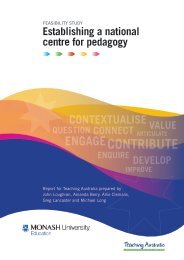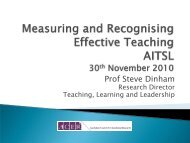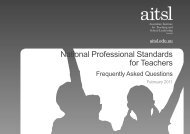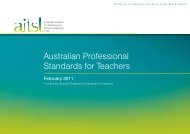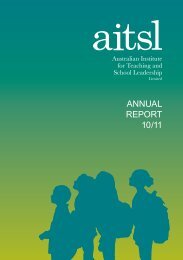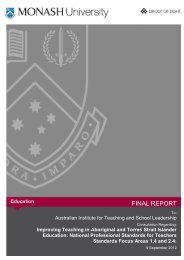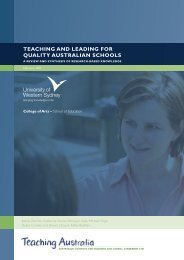Professional Learning Flagship Program: Leading Curriculum Change
Professional Learning Flagship Program: Leading Curriculum Change
Professional Learning Flagship Program: Leading Curriculum Change
Create successful ePaper yourself
Turn your PDF publications into a flip-book with our unique Google optimized e-Paper software.
practice and shape teacher values; social structure, the ‘webs of relationships in which teachers areinvolved’; and teachers’ individual experiences and values which affect their identities and practices.While there were important differences among the schools Priestley studied, he claims that the modelthrows light on the processes of curriculum construction and educational change which would be usefulas a guide for those enacting change.Similar arguments are put by Weston and Bain (2009), who criticise assumptions that stakeholdershave a common understanding of change - assumptions which are not borne out in their research. Thelinear and rational needs analysis approach needs to be combined with an appreciation of the looselycoupled informal culture of schools. A reconciliation of these two approaches must assist stakeholdersto ‘undertake a realistic analysis of their circumstances; learn about themselves in ways that informcommitment to change; and build a school-level schema that reflects commitment and support for thedesired changes’ (Bain 2007, cited in Weston and Bain 2009, p. 159). The process of change must beintegrated with a process of self-understanding which builds the school’s capacity for improvement.Woodbury and Gess-Newsome (2000) review research on school change and identify four potentialexplanations for what they call ‘the phenomenon of change without difference in educational reform’(p. 765), each based on a different perspective on change. These perspectives are the ‘school system’perspective, a functional approach to change, often seeing this as a closed system immune to influencefrom the community and political and other influences. The cultural and structural perspective focuseson the culture of teachers’ and administrators’ habits of mind, shared beliefs and patterns of interactionand behaviour, as well as the structures of teaching such as space, timetables, mandated curricula andassessment and the like.An ‘intent of reform’ perspective distinguishes first-order change aimed at increasing the efficiencyor effectiveness of existing school practices, and second-order change, which seeks to transformfundamental structures and practices, and requires ‘new ways of thinking, acting and organizing ratherthan an assimilation of new ideas into existing patterns’ (Woodbury and Gess-Newsome 2000, p. 770).A particularly important factor, which appears also in the literature on the success of collaborativeprofessional learning, is the degree of trust which characterises professional relationships in schools.While trust is difficult to measure, a number of studies have shown the importance of trust in schoolchange and improvement (Cosner 2009; Daly 2009; Forsyth 2008; Hoy, Gageand Tarter 2006;Tschannen-Moran 2009). Bryk and Schneider’s(2002) 10-year study of more than 400 Chicagoelementary schools found a link between the level of trust in a school and student learning, observingthat ‘trust fosters a set of organizational conditions, some structural and others social-psychological,that make it more conducive for individuals to initiate and sustain the kinds of activities necessary toaffect productivity improvements’ (p. 116). They found that trust among educators lowers their senseof vulnerability as they engage in ‘the new and uncertain tasks associated with reform’, facilitatesproblem-solving, and ‘sustains an ethical imperative … to advance the best interests of children’, andthus ‘constitutes a moral resource for school improvement’ (p. 34). Hoy and Tschannen-Moran, (2003)suggested that when teachers perceived greater levels of trust, they had a greater sense of efficacy.They also found a link between teachers’ trust of principals, colleagues and parents and their willingnessto collaborate with them. Brewster and Railsback (2003) offer useful guidance for leaders on developingtrust in schools.Finally, the teacher thinking perspective focuses on teachers’ knowledge and beliefs about suchthings as the nature of subjects, how students learn, what students are capable of learning, and howchange relates to their understandings and attitudes about institutional and curricular goals of theschool and system in which they work. If teachers’ knowledge and beliefs are incompatible with reformgoals, change will be limited. Equally, Woodbury and Gess-Newsome (2002, p. 771) cite Cohen andBall (1990) in observing that, ‘Teachers’ assimilation of new ideas into the status quo of their practiceengenders their reports of making change where none can be observed’. Roehrig, Kruse and Kern(2007) also highlight the importance of teachers’ beliefs about teaching and learning in curriculumimplementation.7 <strong>Professional</strong> <strong>Learning</strong> <strong>Flagship</strong> <strong>Program</strong>: <strong>Leading</strong> <strong>Curriculum</strong> <strong>Change</strong>: Literature Review




